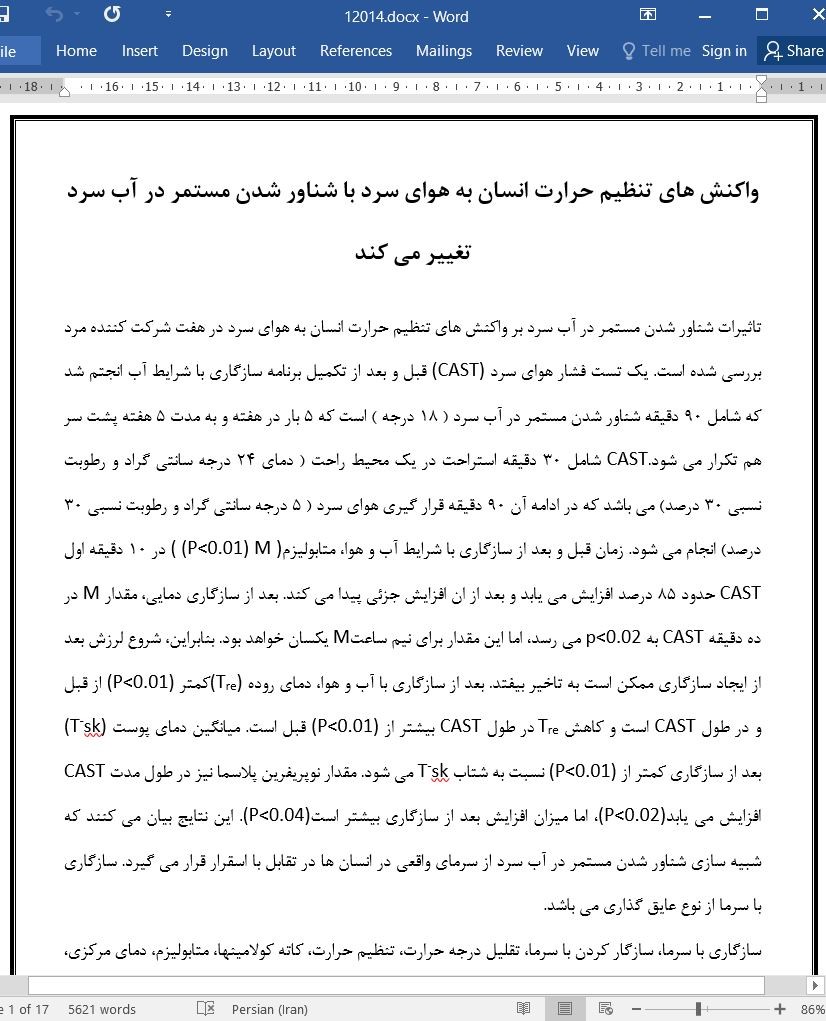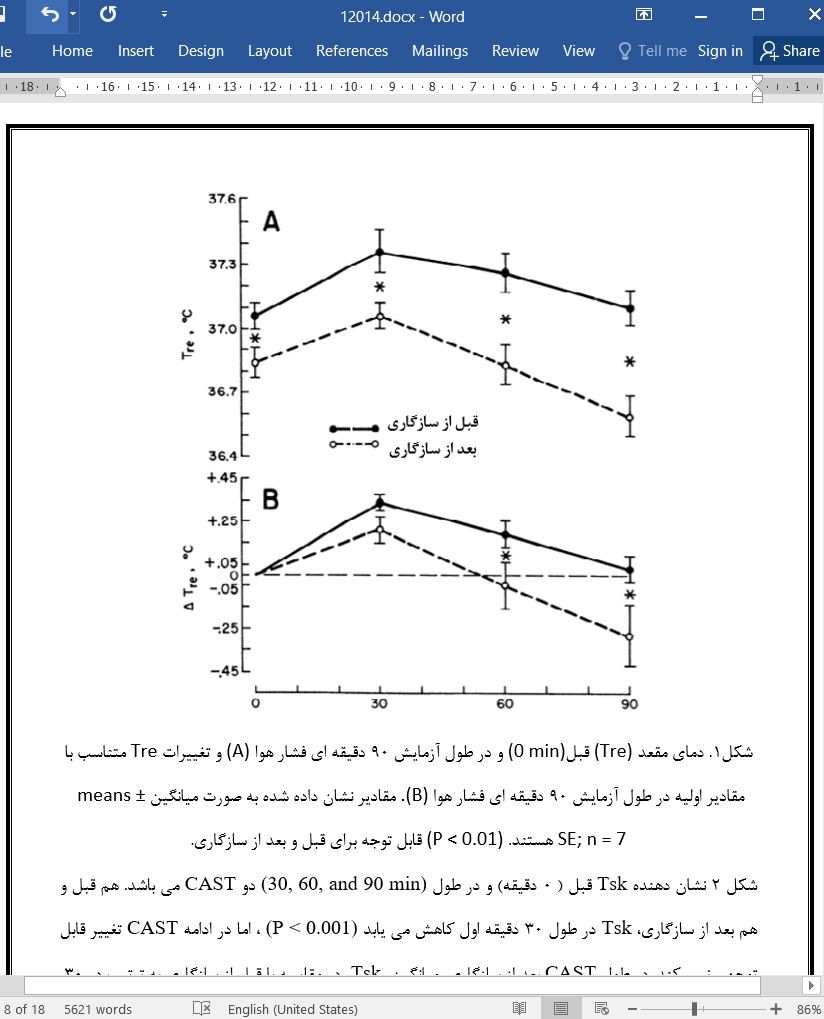
دانلود مقاله تغییر واکنش تنظیم حرارت انسان به هوای سرد با شناور شدن در آب سرد
تاثیرات شناور شدن مستمر در آب سرد بر واکنش های تنظیم حرارت انسان به هوای سرد در هفت شرکت کننده مرد بررسی شده است. یک تست فشار هوای سرد (CAST) قبل و بعد از تکمیل برنامه سازگاری با شرایط آب انجتم شد که شامل 90 دقیقه شناور شدن مستمر در آب سرد ( 18 درجه ) است که 5 بار در هفته و به مدت 5 هفته پشت سر هم تکرار می شود.CAST شامل 30 دقیقه استراحت در یک محیط راحت ( دمای 24 درجه سانتی گراد و رطوبت نسبی 30 درصد) می باشد که در ادامه آن 90 دقیقه قرار گیری هوای سرد ( 5 درجه سانتی گراد و رطوبت نسبی 30 درصد) انجام می شود. زمان قبل و بعد از سازگاری با شرایط آب و هوا، متابولیزم) M ( (P<0.01) در 10 دقیقه اول CAST حدود 85 درصد افزایش می یابد و بعد از ان افزایش جزئی پیدا می کند. بعد از سازگاری دمایی، مقدار M در ده دقیقه CAST به p<0.02 می رسد، اما این مقدار برای نیم ساعتM یکسان خواهد بود. بنابراین، شروع لرزش بعد از ایجاد سازگاری ممکن است به تاخیر بیفتد. بعد از سازگاری با آب و هوا، دمای روده (Tre)کمتر (P<0.01) از قبل و در طول CAST است و کاهش Tre در طول CAST بیشتر از (P<0.01) قبل است. میانگین دمای پوست (T-sk) بعد از سازگاری کمتر از (P<0.01) نسبت به شتاب T-sk می شود. مقدار نوپریفرین پلاسما نیز در طول مدت CAST افزایش می یابد(P<0.02)، اما میزان افزایش بعد از سازگاری بیشتر است(P<0.04). این نتایج بیان می کنند که شبیه سازی شناور شدن مستمر در آب سرد از سرمای واقعی در انسان ها در تقابل با اسقرار قرار می گیرد. سازگاری با سرما از نوع عایق گذاری می باشد.
سازگاری با سرما، سازگار کردن با سرما، تقلیل درجه حرارت، تنظیم حرارت، کاته کولامینها، متابولیزم، دمای مرکزی، دمای پوست
وجود ویژگی سازگاری سرمایی در انسان ها موضوعی است که به خوبی تشریح شده است. برای نمونه، ان دسته از زنان کره ای که پیوسته در آب سرد شنا می کنند دارای آستانه لرزش بالاتری ( دمای آب کمتر) در مقایسه با زنان غیر شناگر هستند(16.19). همچنین، مردان استرالیایی و خانه بدوش های آفریقای جنوبی که سال های طولانی در معرض دماهای بسیار پایین شبانه زندگی کرده اند آستانه سرما و دمای پوست پایین تری در مقایسه با گروه های کنترل هستند(13). انسان های فاقد ویژگی سازگاری با تولید گرمای متابولیت و آستانه سرمای قابل توجه به سرما واکنش می دهند(13.18). میزان عدم دارا بودن تجربه زندگی و واکنش در برابر سرما مشخص نیست. به علاوه، در حالی که روش های سازگاری با سرما می توانند واکنش های متغیر در برابر سرما تولید کنند (3و11و12و14و17و20)، اما میزان ارتباط این تغییرات با خوگیری افراد در برابر سازگاری واقعی نامشخص است.
YOUNG, ANDREW, J., STEPHEN R. MUZA, MICHAEL N. SAWKA, RICHARD R. GONZALEZ, AND KENT 13. PANDOLF. Human thermoregulatory responses to cold air are altered by repeated cold water immersion. J. Appl. Physiol. 60(5): 154% 1548, 1986.-The effects of repeated cold water immersion on thermoregulatory responses to cold air were studied in seven males. A cold air stress test (CAST) was performed before and after completion of an acclimation program consisting of daily 9O-min cold (U?‘C) water immersion, repeated 5 times/wk for 5 consecutive wk. The CAST consisted of resting 30 min in a comfortable [24”C, 30% relative humidity (rh)] environment followed by 90 min in cold (5°C 30% rh) air. Pre- and postacclimation, metabolism (dM) increased (P < 0.01) by 85% during the first 10 min of CAST and thereafter rose slowly. After acclimation, AI was lower (P c 0.02) at 10 min of CAST compared with before, but by 30 min 2M was the same. Therefore, shivering onset may have been delayed following acclimation. After acclimation, rectal temperature (T,,) was lower (P < 0.01) before and during CAST, and the drop in T,, during CAST was greater (P < 0.01) than before. Mean weighted skin temperature (Tsk) was lower (P < 0.01) following acclimation than before, and acclimation resulted in a larger (P < 0.02) T,,- to-T,, gradient. Plasma norepinephrine increased during both CAST (P < 0.002), but the increase was larger (P < 0.004) following acclimation. These findings suggest that repeated cold water immersion stimulates development of true cold acclimation in humans as opposed to habituation. The cold acclimation produced appears to be of the insulative type.
cold acclimatization; cold acclimation; hypothermia; thermoregulation; catecholamines; metabolism; core temperature: skin temperature
has been reasonably well demonstrated. For example, Korean women divers who repeatedly dive in cold water have been reported to have a higher threshold for shivering (lower critical water temperature) than nondivers (16, 19). Also, Australian aborigines and South African bushmen who have lived many years exposed nearly nude to extreme low temperatures at night respond to cold exposure with little or no shivering and lower steadystate core and skin temperature compared with control subjects (13). Nonadapted humans respond to acute cold ’ Throughout this report the term acclimatization will refer to the exposure with marked shivering and elevated metabolic heat production (13, 18). The degree to which persons lacking a lifetime experience of cold stress are able to acclimatize to cold is not known. Furthermore, while cold acclimation procedures have been reported to produce altered responses to cold (3, 11, l&14,17, ZO), the extent to which such changes represent habituation (blunted response) as opposed to true acclimation remains unclear.
روش ها
نتایج
بحث
منابع
METHODS
RESULTS
DISCUSSION
REFERENCES
- ترجمه فارسی مقاله با فرمت ورد (word) با قابلیت ویرایش، بدون آرم سایت ای ترجمه
- ترجمه فارسی مقاله با فرمت pdf، بدون آرم سایت ای ترجمه



